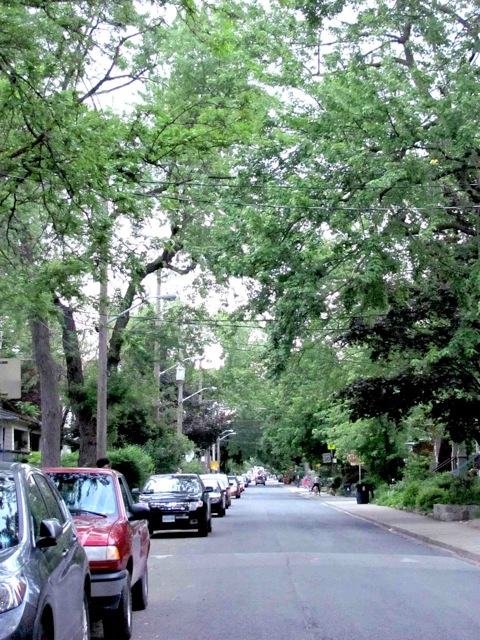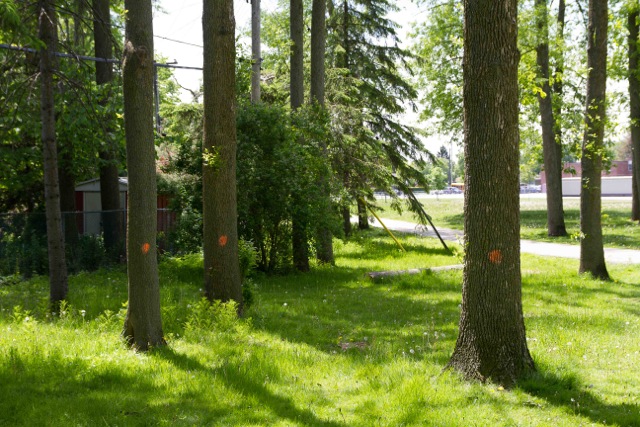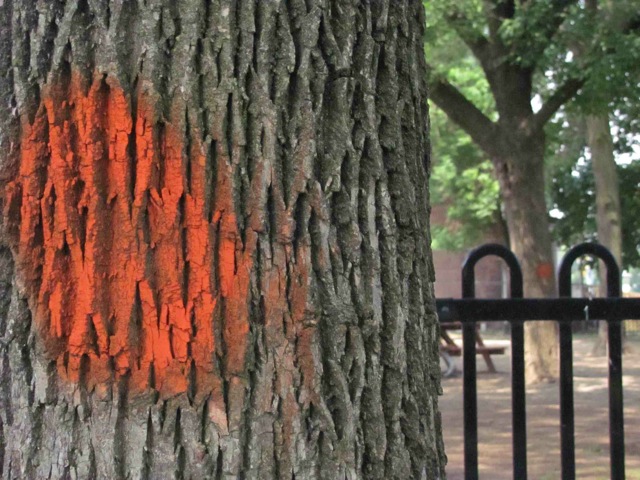This is part one of a three-part series by Jane Clark called “How I Spent My Summer Vacation.”
There’s no getting around it: I’m a tree-hugger. I don’t just like trees, I need them to stay (reasonably) sane. Walking through green spaces calms me. I am lucky to live in the Parkdale–Roncesvalles area, which is graced with many tree-lined streets and mature specimens. But these giants are also at risk. Like other vulnerable and misunderstood beings, trees have no voice, and stand or fall at our whim.

So when one of my leafy neighbours is lost, I grieve. I’ve been known to stand on the sidewalk weeping as I watch crews butchering another old-timer. When I heard about EAB and the enormity of the threat to the city’s ash trees, it didn’t take much to turn this hugger into a campaigner.
Believe me, I didn’t start off with this as my summer plan. In fact, after a stressful year, my plan was to take the entire summer off. And truth be told, at the beginning I couldn’t have identified an ash tree if you’d paid me. So how did I end up trudging sweatily along local streets and avenues with my fellow volunteers, pestering my neighbours on their porches and driveways? The simple answer is I felt I had no choice. I had to act.

I first learned of the EAB epidemic in the summer of 2011 while researching an article on the day-to-day life of an arborist with the city. Last fall, I wrote about EAB again and attended a presentation at city hall hosted by LEAF. By then the news was alarming enough that I immediately signed up as an EAB Ambassador. However, there wasn’t much I could do to rescue ash trees until the next treatment season in the spring, so instead I tried to learn what I could about the situation.
Early this year, I wrote an article about the situation for Spacing magazine. Though I was heartened to learn that the city has a comprehensive program to treat as many of its public trees as possible with a highly effective insecticide called TreeAzinTM, one of the people I interviewed, Urban Forestry’s Kristjan Vitols, had dire news. He told me that due to the speed and severity of the infestation, the city no longer felt that there would be much opportunity to treat trees beyond summer 2013. He had this warning for homeowners with private ash trees: “If you don’t treat your tree this year, it’s probably too late.”
With this ominous pronouncement and end-of-summer deadline in mind, I tried to find out what could be done to improve the odds for private trees. I signed up for training and canvassing, and researched other neighbourhood groups working on the issue. The very helpful staff at LEAF offered advice and materials, and put me in touch with the indomitable Rita Bijons, a volunteer powerhouse in Ward 13. Rita explained how she had organized information sessions, introduced the project under the name Save Our Ash into her community group, Green 13, and partnered with LEAF and her own councillor, Sarah Doucette. She was also canvassing tirelessly. LEAF suggested I involve Gord Perks, my Ward 14 councillor, as well, whose staff arranged to post EAB information and volunteer appeals via social media.

At this point, I was unsure of how to track down private ash trees in my area, and even less sure of how to help if I found any. But I set myself a goal: I decided that if I could manage to get just one ash tree treated in my ward by the August 31st treatment deadline, I would consider my efforts worthwhile. Little did I know that in the coming weeks I would end up organizing my neighbours to arrange bulk treatments and literally save our own ash. But bringing it all about would be the tricky part… (to be continued in part two: “Spreading the word and devising a plan.”)
This post is part one of a multi-part series by Jane Clark, a volunteer and freelance writer based in Toronto’s west end. Watch our blog for the rest of her story in the coming weeks. The EAB Ambassador Program is supported by Ontario Power Generation's Biodiversity Program, Live Green, a project of the City of Toronto, York Region and Ontario Trillium Foundation.
